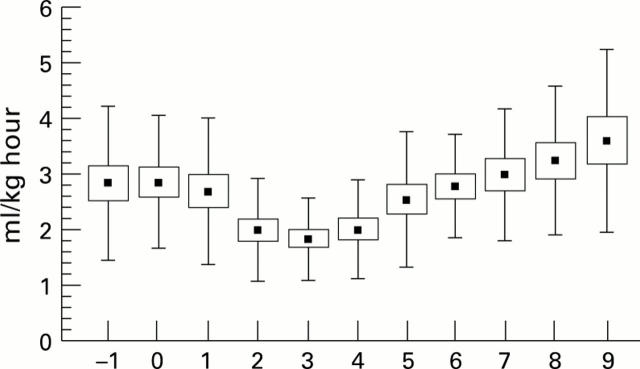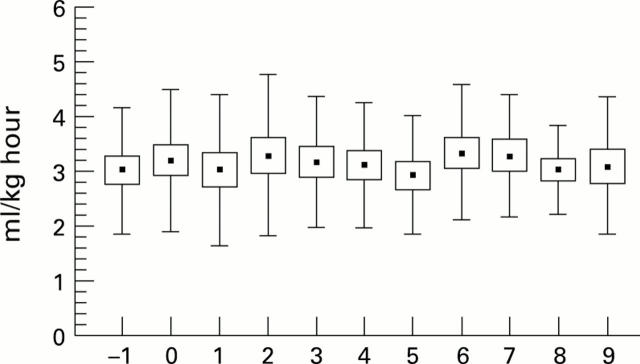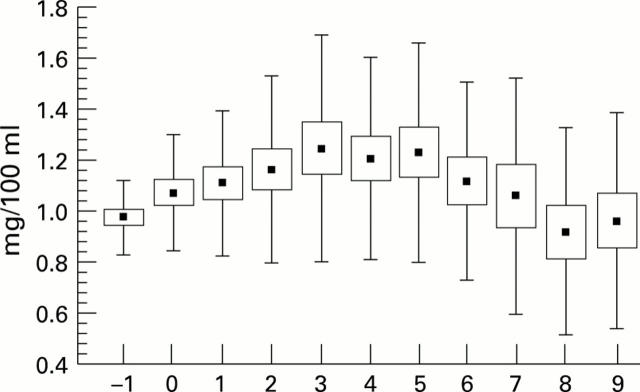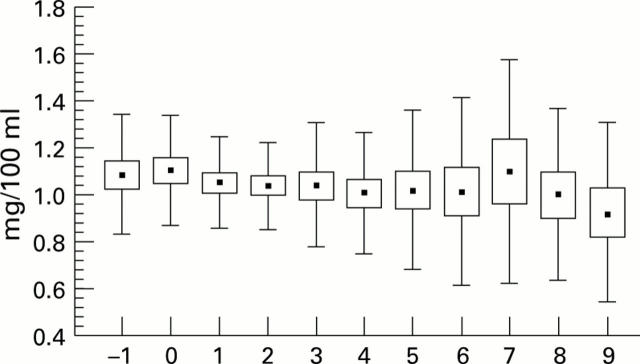Abstract
AIM—To evaluate the efficiency and side effects of ibuprofen for the early treatment of patent ductus arteriosus (PDA)and compare it with indomethacin. METHODS—Forty preterm infants with gestational ages of less than 33 weeks, with respiratory distress syndrome (RDS) and echocardiographically confirmed PDA, were randomly assigned at days 2 to 3 of life to receive either intravenous indomethacin 3 × 0.2 mg/kg at 12 hour intervals or intravenous ibuprofen 1 × 10 mg/kg, followed by 5 mg/kg 24 and 48 hours later. RESULTS—PDA closed in 15 of 20 patients from the indomethacin group (75%) and in 16 of 20 (80%) from the ibuprofen group. Seven patients (three indomethacin, four ibuprofen) required a second treatment with indomethacin and in five (three in the indomethacin group and two in the ibuprofen group) the duct was ultimately ligated. Ibuprofen patients had a better urinary output and showed no increase in serum creatinine concentrations compared with the indomethacin group. Ibuprofen was not associated with any other side effect. CONCLUSIONS—Ibuprofen treatment seems to be as efficient as indomethacin in closing PDA on the third day of life in preterm infants with respiratory distress syndrome and seems to have fewer renal side effects. Keywords: patent ductus arteriosus; respiratory distress syndrome; ibuprofen; indomethacin; Doppler echocardiography
Full Text
The Full Text of this article is available as a PDF (133.0 KB).
Figure 1 .
Urine production in the indomethacin group (upper panel) and the ibuprofen group (lower panel) over 11 days. Day 0 = start of treatment; means ± 1 SE, ± 1 SD. There was a significant difference between the two groups on days 2, 3, and 4 (P=0.002).
Figure 2 .
Serum creatinine concentration in the indomethacin group (upper panel) and the ibuprofen group (lower panel) over 11 days. Day 0 = start of treatment; means ± 1 SE ± 1 SD. Maximal difference between the two groups occurred on day 3 (P= 0.07).
Selected References
These references are in PubMed. This may not be the complete list of references from this article.
- Chemtob S., Beharry K., Rex J., Varma D. R., Aranda J. V. Prostanoids determine the range of cerebral blood flow autoregulation of newborn piglets. Stroke. 1990 May;21(5):777–784. doi: 10.1161/01.str.21.5.777. [DOI] [PubMed] [Google Scholar]
- Chemtob S., Laudignon N., Beharry K., Rex J., Varma D., Wolfe L., Aranda J. V. Effects of prostaglandins and indomethacin on cerebral blood flow and cerebral oxygen consumption of conscious newborn piglets. Dev Pharmacol Ther. 1990;14(1):1–14. [PubMed] [Google Scholar]
- Cifuentes R. F., Olley P. M., Balfe J. W., Radde I. C., Soldin S. J. Indomethacin and renal function in premature infants with persistent patent ductus arteriosus. J Pediatr. 1979 Oct;95(4):583–587. doi: 10.1016/s0022-3476(79)80775-1. [DOI] [PubMed] [Google Scholar]
- Clyman R. I. Recommendations for the postnatal use of indomethacin: an analysis of four separate treatment strategies. J Pediatr. 1996 May;128(5 Pt 1):601–607. doi: 10.1016/s0022-3476(96)80123-5. [DOI] [PubMed] [Google Scholar]
- Coceani F., White E., Bodach E., Olley P. M. Age-dependent changes in the response of the lamb ductus arteriosus to oxygen and ibuprofen. Can J Physiol Pharmacol. 1979 Aug;57(8):825–831. doi: 10.1139/y79-126. [DOI] [PubMed] [Google Scholar]
- Coombs R. C., Morgan M. E., Durbin G. M., Booth I. W., McNeish A. S. Gut blood flow velocities in the newborn: effects of patent ductus arteriosus and parenteral indomethacin. Arch Dis Child. 1990 Oct;65(10 Spec No):1067–1071. doi: 10.1136/adc.65.10_spec_no.1067. [DOI] [PMC free article] [PubMed] [Google Scholar]
- Cotton R. B., Stahlman M. T., Bender H. W., Graham T. P., Catterton W. Z., Kovar I. Randomized trial of early closure of symptomatic patent ductus arteriosus in small preterm infants. J Pediatr. 1978 Oct;93(4):647–651. doi: 10.1016/s0022-3476(78)80910-x. [DOI] [PubMed] [Google Scholar]
- Edwards A. D., Wyatt J. S., Richardson C., Potter A., Cope M., Delpy D. T., Reynolds E. O. Effects of indomethacin on cerebral haemodynamics in very preterm infants. Lancet. 1990 Jun 23;335(8704):1491–1495. doi: 10.1016/0140-6736(90)93030-s. [DOI] [PubMed] [Google Scholar]
- Ellison R. C., Peckham G. J., Lang P., Talner N. S., Lerer T. J., Lin L., Dooley K. J., Nadas A. S. Evaluation of the preterm infant for patent ductus arteriosus. Pediatrics. 1983 Mar;71(3):364–372. [PubMed] [Google Scholar]
- Fajardo C. A., Whyte R. K., Steele B. T. Effect of dopamine on failure of indomethacin to close the patent ductus arteriosus. J Pediatr. 1992 Nov;121(5 Pt 1):771–775. doi: 10.1016/s0022-3476(05)81914-6. [DOI] [PubMed] [Google Scholar]
- Fowlie P. W. Prophylactic indomethacin: systematic review and meta-analysis. Arch Dis Child Fetal Neonatal Ed. 1996 Mar;74(2):F81–F87. doi: 10.1136/fn.74.2.f81. [DOI] [PMC free article] [PubMed] [Google Scholar]
- Friedman Z., Whitman V., Maisels M. J., Berman W., Jr, Marks K. H., Vesell E. S. Indomethacin disposition and indomethacin-induced platelet dysfunction in premature infants. J Clin Pharmacol. 1978 May-Jun;18(5-6):272–279. doi: 10.1002/j.1552-4604.1978.tb02446.x. [DOI] [PubMed] [Google Scholar]
- Gersony W. M., Peckham G. J., Ellison R. C., Miettinen O. S., Nadas A. S. Effects of indomethacin in premature infants with patent ductus arteriosus: results of a national collaborative study. J Pediatr. 1983 Jun;102(6):895–906. doi: 10.1016/s0022-3476(83)80022-5. [DOI] [PubMed] [Google Scholar]
- Gonzalez A., Sosenko I. R., Chandar J., Hummler H., Claure N., Bancalari E. Influence of infection on patent ductus arteriosus and chronic lung disease in premature infants weighing 1000 grams or less. J Pediatr. 1996 Apr;128(4):470–478. doi: 10.1016/s0022-3476(96)70356-6. [DOI] [PubMed] [Google Scholar]
- Grosfeld J. L., Kamman K., Gross K., Cikrit D., Ross D., Wolfe M., Katz S., Weber T. R. Comparative effects of indomethacin, prostaglandin E1, and ibuprofen on bowel ischemia. J Pediatr Surg. 1983 Dec;18(6):738–742. doi: 10.1016/s0022-3468(83)80015-3. [DOI] [PubMed] [Google Scholar]
- Hammerman C., Aramburo M. J. Prolonged indomethacin therapy for the prevention of recurrences of patent ductus arteriosus. J Pediatr. 1990 Nov;117(5):771–776. doi: 10.1016/s0022-3476(05)83342-6. [DOI] [PubMed] [Google Scholar]
- Kauffman R. E., Nelson M. V. Effect of age on ibuprofen pharmacokinetics and antipyretic response. J Pediatr. 1992 Dec;121(6):969–973. doi: 10.1016/s0022-3476(05)80354-3. [DOI] [PubMed] [Google Scholar]
- Kluckow M., Evans N. Early echocardiographic prediction of symptomatic patent ductus arteriosus in preterm infants undergoing mechanical ventilation. J Pediatr. 1995 Nov;127(5):774–779. doi: 10.1016/s0022-3476(95)70172-9. [DOI] [PubMed] [Google Scholar]
- Mahony L., Carnero V., Brett C., Heymann M. A., Clyman R. I. Prophylactic indomethacin therapy for patent ductus arteriosus in very-low-birth-weight infants. N Engl J Med. 1982 Mar 4;306(9):506–510. doi: 10.1056/NEJM198203043060903. [DOI] [PubMed] [Google Scholar]
- Malcolm D. D., Segar J. L., Robillard J. E., Chemtob S. Indomethacin compromises hemodynamics during positive-pressure ventilation, independently of prostanoids. J Appl Physiol (1985) 1993 Apr;74(4):1672–1678. doi: 10.1152/jappl.1993.74.4.1672. [DOI] [PubMed] [Google Scholar]
- Meade E. A., Smith W. L., DeWitt D. L. Differential inhibition of prostaglandin endoperoxide synthase (cyclooxygenase) isozymes by aspirin and other non-steroidal anti-inflammatory drugs. J Biol Chem. 1993 Mar 25;268(9):6610–6614. [PubMed] [Google Scholar]
- Patel J., Marks K. A., Roberts I., Azzopardi D., Edwards A. D. Ibuprofen treatment of patent ductus arteriosus. Lancet. 1995 Jul 22;346(8969):255–255. doi: 10.1016/s0140-6736(95)91304-1. [DOI] [PubMed] [Google Scholar]
- Rennie J. M., Cooke R. W. Prolonged low dose indomethacin for persistent ductus arteriosus of prematurity. Arch Dis Child. 1991 Jan;66(1 Spec No):55–58. doi: 10.1136/adc.66.1_spec_no.55. [DOI] [PMC free article] [PubMed] [Google Scholar]
- Sakhalkar V. S., Merchant R. H. Therapy of symptomatic patent ductus arteriosus in preterms using mefenemic acid and indomethacin. Indian Pediatr. 1992 Mar;29(3):313–318. [PubMed] [Google Scholar]
- Seyberth H. W., Rascher W., Hackenthal R., Wille L. Effect of prolonged indomethacin therapy on renal function and selected vasoactive hormones in very-low-birth-weight infants with symptomatic patent ductus arteriosus. J Pediatr. 1983 Dec;103(6):979–984. doi: 10.1016/s0022-3476(83)80736-7. [DOI] [PubMed] [Google Scholar]
- Shankaran S., Cepeda E., Muran G., Mariona F., Johnson S., Kazzi S. N., Poland R., Bedard M. P. Antenatal phenobarbital therapy and neonatal outcome. I: Effect on intracranial hemorrhage. Pediatrics. 1996 May;97(5):644–648. [PubMed] [Google Scholar]
- Shankaran S., Slovis T. L., Bedard M. P., Poland R. L. Sonographic classification of intracranial hemorrhage. A prognostic indicator of mortality, morbidity, and short-term neurologic outcome. J Pediatr. 1982 Mar;100(3):469–475. doi: 10.1016/s0022-3476(82)80462-9. [DOI] [PubMed] [Google Scholar]
- Stefano J. L., Abbasi S., Pearlman S. A., Spear M. L., Esterly K. L., Bhutani V. K. Closure of the ductus arteriosus with indomethacin in ventilated neonates with respiratory distress syndrome. Effects of pulmonary compliance and ventilation. Am Rev Respir Dis. 1991 Feb;143(2):236–239. doi: 10.1164/ajrccm/143.2.236. [DOI] [PubMed] [Google Scholar]
- Van Bel F., Van Zoeren D., Schipper J., Guit G. L., Baan J. Effect of indomethacin on superior mesenteric artery blood flow velocity in preterm infants. J Pediatr. 1990 Jun;116(6):965–970. doi: 10.1016/s0022-3476(05)80662-6. [DOI] [PubMed] [Google Scholar]
- Van Bel F., Van de Bor M., Stijnen T., Baan J., Ruys J. H. Cerebral blood flow velocity changes in preterm infants after a single dose of indomethacin: duration of its effect. Pediatrics. 1989 Nov;84(5):802–807. [PubMed] [Google Scholar]
- Varvarigou A., Bardin C. L., Beharry K., Chemtob S., Papageorgiou A., Aranda J. V. Early ibuprofen administration to prevent patent ductus arteriosus in premature newborn infants. JAMA. 1996 Feb 21;275(7):539–544. [PubMed] [Google Scholar]
- Wolf W. M., Snover D. C., Leonard A. S. Localized intestinal perforation following intravenous indomethacin in premature infants. J Pediatr Surg. 1989 Apr;24(4):409–410. doi: 10.1016/s0022-3468(89)80284-2. [DOI] [PubMed] [Google Scholar]
- Yeh T. F., Wilks A., Singh J., Betkerur M., Lilien L., Pildes R. S. Furosemide prevents the renal side effects of indomethacin therapy in premature infants with patent ductus arteriosus. J Pediatr. 1982 Sep;101(3):433–437. doi: 10.1016/s0022-3476(82)80079-6. [DOI] [PubMed] [Google Scholar]
- van Bel F., Guit G. L., Schipper J., van de Bor M., Baan J. Indomethacin-induced changes in renal blood flow velocity waveform in premature infants investigated with color Doppler imaging. J Pediatr. 1991 Apr;118(4 Pt 1):621–626. doi: 10.1016/s0022-3476(05)83391-8. [DOI] [PubMed] [Google Scholar]
- van Overmeire B., Brus F., van Acker K. J., van der Auwera J. C., Schasfoort M., Elzenga N. J., Okken A. Aspirin versus indomethacin treatment of patent ductus arteriosus in preterm infants with respiratory distress syndrome. Pediatr Res. 1995 Dec;38(6):886–891. doi: 10.1203/00006450-199512000-00010. [DOI] [PubMed] [Google Scholar]






